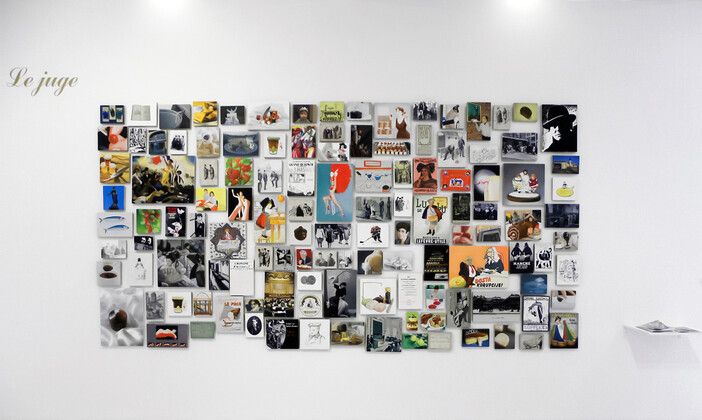ZHOU TIEHAI 周铁海
b. 1966, works and lives in Shanghai

ZHOU TIEHAI 周铁海
ZTHU210
2008
158pcs in all of different size (the minimal one:15x10cm ; the maximal one:40x53cm)
158 pieces
Introduction
Zhou Tiehai was born in 1966 in Shanghai, where he also lives and works today.Zhou Tiehai's conceptual projects represent the artist's vengeful attitude towards the self-absorbed art market. His work's power to amaze and provoke is the result of a host of strategies that mix antagonism with sincerity. The key ingredients that drive Zhou Tiehai's unsettling yet amusing practice include appropriating classical imagery, generating ironic projections, proclaiming laconic yet heartfelt discourse, and actively subverting painterly craft. He takes on the role of both artist and patron as many of his airbrush paintings are rendered by assistants under his supervision. He permits himself to 'play' with art's historical baggage by making paintings that are simultaneously self-aware and self-abnegating, virtuosic and pop culture are both present within a single canvas. He manipulates acclaimed magazine covers for his own purposes and articulates the notion of 'artistic agency' within current conditions of the art world and global economy. He makes self-promotional images that subvert the establishment notion of how artists should look and behave.
In the "Placebo" and "Ego"(2006) series, Zhou Tiehai ironically replaces his subject's faces with a camel's head. He chooses canonical portraits by da Vinci, Goya, and Ingres as well as contemporary stars like Jeff Koons, Richard Prince, and Maurizio Cattelan as his models. Here too, the airbrush technique subverts the 'genius' brushstroke that is the 'inspired' individual signature of the classical master. A placebo is a substitute drug. It is an inert substance administered to stimulate the patient's psychosomatically induced curative effect. The constructed and appropriated imagery of Zhou Tiehai's praxis thus functions as a 'real' placebo. He makes critical art, but not in the conventional understanding of the term. While his works display a narrative that draws on contemporary topics, the mechanisms of artistic reception, and the market, he strategically refrains from making any clear value judgments.
Selected solo exhibitions: Will/We Must, Yuz Museum, Shanghai (2017); Desserts, Zhou Tiehai, MoCA, Shanghai (2010); An Other History, Shanghai Art Museum, Shanghai (2006); Tonic +', Solo Show by Zhou Tiehai, ShanghART H-Space, Shanghai (2004); Zhou Tiehai, Marella Arte Contemporanea, Milan, Italy (2003); The Artist isn't Here, Zhou Tiehai Solo Exhibition, ISE Foundation, New York, U.S.A. & ShanghART Fuxing Park, Shanghai (2001); Placebo Swiss, Hara Museum, Tokyo, Japan (2000); Zhou Tiehai, Kunsthal Rotterdam, The Netherlands (1998); Too Materialistic, Too Spiritualized, CIFA Gallery, Beijing (1996).
Selected group exhibition: M+ Sigg Collection: From Revolution to Globalisation, M+ Museum, Hong Kong (2021); Art and China After 1989: Theater of the World, Solomon R. Guggenheim Museum, New York, U.S.A.; Bilbao, Spain (2017/2018); Food. Dal Cucchiaio Al Mondo, MAXXI, Rome, Italy (2015); Myth/History: Yuz Collection of Contemporary Art, Yuz Museum, Shanghai (2014); Shanghai/Paris, Modern Art of China, China Art Museum, Shanghai (2013); Portrait of the Times, 30 Years of Chinese Contemporary Art, Power Station of Art, Shanghai (2013); The 7th Asia Pacific Triennial of Contemporary Art, Queensland Art Gallery, Australia (2012); The Global Contemporary, Art Worlds After 1989, ZKM | Center for Art and Media, Karlsruhe, Germany (2011); Shanghai, Asian Art Museum, San Francisco, U.S.A. (2010); Shanghai Kino, Kunsthalle Bern, Switzerland (2009); The Real Thing , Contemporary Art from China, Tate Liverpool, U.K.; IVAM, Valencia, Spain (2007/2008);The 5th Asia Pacific Triennial of Contemporary Art, Queensland Art Gallery, Australia (2006); 2nd Prague Biennale, National Gallery, Prague, Czech Republic (2005); 5th Shanghai Biennale, Shanghai Art Museum, Shanghai (2004); The American Effect, Whitney Museum, New York, U.S.A. (2003); 4th Gwangju Biennial, Gwangju, Korea (2002); Living in Time, 29 Contemporary Artists from China, Hamburger Bahnhof - Museum für Gegenwart, Berlin, Germany (2001); 48th International Art Exhibition Venice Biennale, Italy (1999); Cities on the Move, Exhibition of Asian Art, Secession, Vienna, Austria, etc. (touring exhibition 1997-1999).

